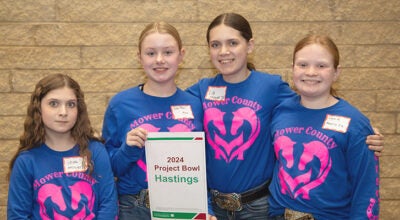Volunteers to search for E. coli causes in the Cedar
Published 8:56 am Wednesday, May 24, 2017
A group of volunteers is in the early stages of testing points on the Cedar River in Mower County to trace the causes of E. coli in the river, and they want Mower County’s help in the process.
About eight adult volunteers — with the help of youth volunteers — with Austin’s Chapter 10 of the Izaak Walton League will use McKnight Foundation grant dollars to collect samples to test for E. coli bacteria.
“[We’re] looking for sources of specific contaminations,” Ikes member Larry Dolphin said.
The volunteers went to the Mower County board Tuesday to request use of county resources.
Ikes member Bill Buckley said the work will complement the recent work of the county and groups like the Cedar River Watershed District.
The plan is to first identify possible hot spots and then work collaboratively to find potential solutions. After initial testing, which is slated to start in June, the group will then complete genetic tests to determine if the E. coli is coming from wild animals, like a raccoon or goose, or from cattle, septic systems or farms.
“We’re just looking to see if we can find some of these hot spots or areas where there’s still contamination, and we want to differentiate between the wildlife aspect of it and feedlots and septics,” Buckley said.
“There’s some things that we, the county, can do things about and some we can’t,” Buckley added.
Dolphin, the retired director of the Jay C. Hormel Nature Center, is no stranger to water testing. E. coli was commonly found in water tests at the nature center, but levels would be higher after flood events, he noted.
The thought is that water comes into contact with contaminants at a feedlot, farm or other property during the high water events.
After discussions with state officials, the Ikes volunteers want to take samples from the river at various states — regular flows, high water and low water.
The Minnesota division of the Izaak Walton League is leading the grant, and Mower County is the second phase of the project, with the first coming on the Minnesota River. The project aims to foster conversations and collaborations among farmers, outdoor recreation enthusiasts, Ikes members and local residents.
The intent is to gradually change land practices and improve water quality through a sequence of community ownership of natural resources, an Ikes press release said.
Depending on the results of the research, Ikes volunteers could look to partnerships with neighboring counties in Minnesota and Iowa.
Before the testing gets underway in June, Ikes volunteers are asking the county for help. The volunteers want to use up to four hours of Environmental Services Supervisor Angie (formerly Knish) Lipelt’s time each month on the project.
For starters, the volunteers want to form maps of feedlots and other potential sources through county systems and records. But County Coordinator Craig Oscarson noted data may be best accessed through the county’s IT department, not Lipelt.
Some of those records and maps may be available already through the county’s geographic information system (GIS), or the IT department could possibly generate such maps.
The question may come down to money. Oscarson asked Ikes volunteers for a more detailed outline of potential services and maps they’re requesting from the county. That way, the county can see what it already has and gauge how much staff time it’d take to meet additional needs.
The county board could then ask the Ikes to pay for county services, or the board could offer the services for free as a partnership.
Ikes leaders plan to eventually take their findings to Lipelt to look for potential solutions.
“We just want to inform your staff — Angie [Lipelt] in this case — what we find and what it implicates,” Buckley said.



